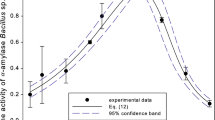Abstract
A solution of α-amylase liquefied cassava starch, 30% (w/v), was saccharified with amyloglucosidase at 45°C, pH 4.5, in a batch reactor in the presence and absence of added glucose. Reactor conversion results were modeled with a multisubstrate model that considers intermediate dextrins of starch hydrolysis, reversibility of some reactions, substrate and product inhibition, and competition among dextrins and isomaltose formation. Kinetic parameters were obtained from initial velocity saccharification tests at different starch concentrations and from the literature. The model can represent well the saccharification of cassava starch even in the presence of a great excess of glucose (100 g/L), added to test its capability.
Similar content being viewed by others
Abbreviations
- CA :
-
liquefied starch concentration, g/L
- CAo :
-
initial starch concentration, 300 g/L
- Cg :
-
glucose concentration, g/L
- Cga :
-
concentration of added glucose, g/L
- Cgi :
-
glucose concentration at the start of saccharification, g/L
- E:
-
enzyme concentration, mL of enzyme stock solution/L of substrate solution
- f:
-
ratio of molecular weights for the anhydroglucose unit in starch and glucose, f = 162/180 = 0.9
- G:
-
glucose molar concentration, mol/L
- G2 :
-
maltose molar concentration, mol/L
- G3 :
-
maltotriose molar concentration, mol/L
- G4 :
-
susceptible oligosaccharides molar concentration, mol/L
- G6 :
-
resistant oligosaccharides molar concentration, mol/L
- GI :
-
isomaltose molar concentration, mol/L
- Geq, G2eq, G3eq, Gleq :
-
quilibrium molar concentration for glucose, maltose, maltotriose, and isomaltose, respectively, mol/L
- kcat :
-
reaction rate constant related to product formation, ol/(h·mL of enzyme)
- Keq2, Keq3, KeqI :
-
equilibrium constants for maltose (mol/L), maltotriose (mol/L), and isomaltose (L/mol), respectively
- Ki :
-
product (glucose) inhibition constant, mol/L
- Km2, Km3, Km4, Km6 :
-
Michaelis-Menten constants for maltose, maltotriose, susceptible oligosaccharides, and resistant oligosaccharides, respectively, mol /L
- KS :
-
substrate inhibition constant, mol/L
- MG :
-
molecular weight of glucose, 180 g/gmol
- n:
-
average degree of polymerization, dimensionless
- r2, r3, r4, r6, r1 :
-
rate of reaction for maltose, maltotriose, susceptible oligosaccharides, resistant oligosaccharides, and isomaltose, respectively, mol/(L·h)
- t:
-
reaction time, h
- V:
-
initial rate of glucose production, g/(L·h)
- VIM :
-
second-order rate constant for isomaltose, L2/(mol·h·mL of enzyme)
- Vm2, Vm3, Vm4, Vm6 :
-
maximum velocity constants associated with the reaction rate of maltose, maltotriose, susceptible oligosaccharides, and resistant oligosaccharides, respectively, mol/(h·mL of enzyme)
- XA :
-
conversion of liquefied starch to glucose, %
- α:
-
parameter in Eq. (22), a = (CAo/kcat) (1-Km/K+CAo/KS), mL of enzyme·h/L
- β:
-
parameter in Eq. (22), β = (Km/kcat) (1 + Cgi/Ki + CAo/Ki), mL of enzyme·h/L
- γ:
-
parameter in Eq. (22), γ = C 2Ao /(2K S kcat), ml of enzymeh/L
- τb :
-
normalized reaction time, τb = E·t, mL of enzyme·h/L
References
Zanin, G. M. (1989), Sacarificação de amido em reator de leito fluidizado com enzima amiloglicosidase imobilizada. Ph. D. Thesis, Faculdade de Engenharia de Alimentos, Universidade Estadual de Campinas, Campinas-SP, Brazil.
Zanin, G. M. and de Moraes, F. F. (1984), Proceedings of XII Encontro sobre Escoamento em Meios Porosos, Maringá-PR, Brazil,October,I, 267–285.
Zanin, G. M., Neitzel, I., and de Moraes, F. F. (1993),Appl. Biochem. Biotechnol. 39/40, 477–489.
Zanin, G. M., Kambara, L. M., Calsavara, L. P. V., and de Moraes, F. F. (1994),Appl. Biochem. Biotechnol. 45/46, 627–639.
Zanin, G. M. and de Moraes, F. F. (1995),Appl. Biochem. Biotechnol. 51/52, 253–262.
Zanin, G. M. and de Moraes, F. F. (1988),Revista Microbiologia 20, 367–371.
Lee, D. D., Lee, G. K., Reilly, P. J., and Lee, Y. Y. (1980),Biotechnol. Bioeng. 22, 1–17.
Marc, A., Duc, G., and Engasser, J. M. (1984),Proceedings of Third European Congress on Biotechnology, vol. II, Springer-Verlag, pp. 103–108.
Marc, A., Engasser, J. M., Moll, M., and Flayeux, R. A. (1983),Biotechnol. Bioeng. 25, 481–496.
Beschkov, V., Marc, A., and Engasser, J. M. (1984),Biotechnol. Bioeng. 26, 22–26.
Marc, A. (1985), Cinétique et modelisation de réacteurs á glucoamylase soluble et immobilisée. Docteur d’Etat thesis, Institute Polytechnique de Lorraine, France.
Reilly, P. J. (1985), inStarch Conversion Technology, Van Beynum, G. M. A. and Roels, J. A., eds., Marcel Dekker, New York, pp. 101–114.
Cooper, G. R. and McDaniel, V. (1970),Clin. Chem. 6, 159–170.
Lowry, O. H., Rosebrough, N. J., Farr, A. L., and Randall, R. J. J. (1975),Biol. Chem. 193, 265–275.
Van Den Heuvel, J. C., and Beeftink, H. H. (1988),Biotechnol. Bioeng. 31, 718–724.
Segel, I. H. (1975),Enzyme Kinetics-Behavior and Analysis of Rapid Equilibrium and Steady-State Enzyme Systems, John Wiley, New York, pp. 210,211.
Author information
Authors and Affiliations
Rights and permissions
About this article
Cite this article
Zanin, G.M., De Moraes, F.F. Modeling cassava starch saccharification with amyloglucosidase. Appl Biochem Biotechnol 57, 617–625 (1996). https://doi.org/10.1007/BF02941742
Issue Date:
DOI: https://doi.org/10.1007/BF02941742




